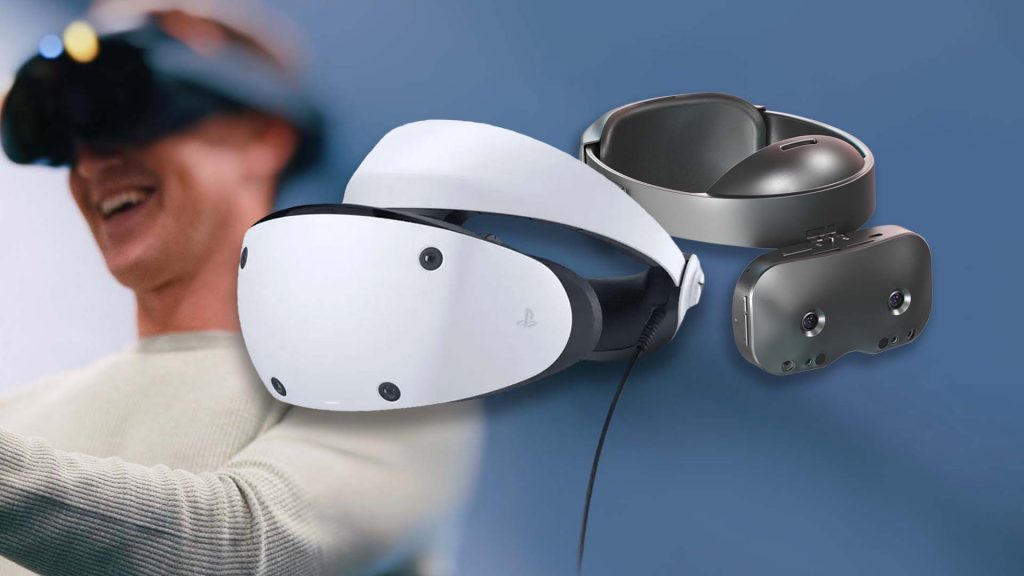Rumored and Confirmed AR & VR Headset Releases – 2022 And Beyond: Apple, PSVR 2 & More


There’s a lot of hardware on the horizon, with confirmed and rumored AR and VR headsets abound — PSVR 2, an Apple mixed reality headset, the Lynx R-1 and more.
If you’re looking for the best pick for existing headsets, we have a guide for the best VR headset in 2022. However, there’s lots of VR and AR hardware releases to come — here’s our list of all the major rumored and confirmed VR/AR hardware set for release in 2022 and beyond.
PSVR 2

Sony confirmed PSVR 2 last year and have since released further tidbits of information over time. However, there’s one thing we still don’t know — the release date.
That being said, it seems very unlikely that PSVR 2 will release this year. A 2023 release looks almost certain at this point — Sony hinted as much in a blog post, and supply chain analyst Kuo has also suggested a 2023 release is likely.
So what do we know? We’ve got a good look at the white and black design with a halo strap design, an OLED display with near-4K resolution, wider field of view, eye tracking and in-headset vibration. It even has a button you can press to see the physical world.
Just like the original PSVR, the headset is tethered and will connect to a PS5 via a single cord. There’s also new (and bundled) Sense controllers. You can read more about PSVR 2 here.
Apple Headset

Apple has yet to officially confirm the existence of its mixed reality headset. But between reports, job listings, code findings, and more, there’s enough indicators for us to confidently say Apple is working on a headset behind closed doors.
So when will it release? Presuming it does make it to market (which still isn’t guaranteed, especially given the reported troubles during development), the latest prediction seems to be mid 2023.
What will the headset offer? According to several reports, it seems like it will be a premium headset with a “hybrid of VR and AR capabilities” with cameras mounted on the outside and an overall slim and light design.
Reports also indicate it could have eye tracking and use dual 4K screens, while running a new operating system – rOS (“reality OS”). Reportedly, this system may include VR versions of Apple apps like Facetime, Maps, Notes and Calendar, as well as functionality that can extend your Mac’s display into the headset.
You can read more about Apple’s rumored headset here.
Lynx-R1

This standalone AR-VR hybrid headset from French startup Lynx has a slim form factor, dual 1600×1600 90Hz LCD panels and is slated to ship this year.
It uses the same Snapgradon XR2 processor found in the Quest 2 and Vive Focus 3, but with the addition of two high-res color cameras for passthrough AR. Hand tracking is the primary input method — powered by two dedicated IR cameras on the front — but optional controllers will also be available, at extra cost.
The Lynx-R1 shipping date has slipped a couple of times — most recently from a June/July 2022 date. But now it’s scheduled to ship to Kickstarter backers “sometime in the summer.” The optional controllers won’t ship alongside the initial hardware release — they will arrive at a later (as yet unconfirmed) date.
Tilt Five

Tilt Five is an AR headset aimed at tabletop play. The main hardware consists of a pair of eyewear-like AR glasses with 110-degree field of view and a wand-like controller to interact with AR content.
However, unlike some other AR hardware, the Tilt Five glasses are designed to work specifically in a tabletop setting, with a retroreflective board that can show augmented content above and below the flat surface. The glasses achieve this with a system that uses projection and reflection with the board, making it perfect for content like tabletop board games or something like Demeo, though notably Demeo hasn’t given any indications yet that it’s being ported to the system.

There’s support for multiple users via several glasses — a 3-pack of glasses is available — but each individual pair still needs to connect to its own an external computing device (which, at the time of writing, supports only a PC). Tilt Five is working to change that, though, with work on both Android support and multiple glasses powered by a single computing device.
Tilt Five are working on delivering kits to Kickstarter backers over this summer but they are taking reservations still and broader availability should follow.
Quest Pro

Meta’s upcoming high-end headset is set to release later this year, sold alongside Quest 2 but at a “significantly” higher price point — more than $800. Meta revealed the headset last year at Connect, dubbing it ‘Project Cambria’, but recent findings suggest the official product name will be Quest Pro.

The headset features a more balanced design and will be aimed at remote workers and mixed reality early adopters. Reports indicate it will feature pancake lenses, higher resolution color cameras, a depth sensor, and support for eye and face tracking.
Meta is “laser-focused on the successful launch of Cambria”, which is set for release later this year.
Pico 4 & Pico 4 Pro

As spotted by Protocol, recent FCC filings indicate Pico 4 and Pico 4 Pro headsets are on the way from TikTok-owner ByteDance. The headsets would be successors to the recently-launched Pico Neo Link 3, which we dubbed a “decent” Quest 2 alternative in our review.
There’s not much we know about the headsets, except that the Pro model looks likely to have additional face and eye tracking functionality. Release dates remain unknown, but Pico hinted that successor headsets would be likely to drop within 12 months after the Neo 3’s Western launch back in April 2022. They’re also looking to offer discounts to Neo Link 3 buyers who want to upgrade when the time comes.
Pimax Reality 12K QLED

This standalone headset is scheduled to begin shipping in Q4 2022, featuring near-6K per eye resolution and an astonishing 200-degree horizontal field of view.
Pimax says the headset will use HDR panels along with four cameras on the front edge for inside-out tracking with support for Pimax’s Touch-like controllers or controller-free hand tracking. Pimax also says it will have integrated eye tracking cameras, in partnership with Tobii, and an array of cameras on the bottom and side of the headset for facial expression and full body tracking. This would be a first for the industry, if shipped.
The company also claims Reality will support two PC VR modes, using either wireless technology over Wi-Fi or a high-fidelity mode with a fiber optic cable or dedicated WiGig transmitter, presumably sold separately.
You can read more about the Reality here. It’s worth noting that the Reality is a very ambitious headset, produced by a company with a long history of delays. As such, in the past we’ve recommended readers treat Pimax more like backing a Kickstarter project.
Pre-orders for the Reality are meant to begin this summer (with a trade-in programs for existing Pimax headset owners), starting from $2400.
Pimax Crystal QLED

The Pimax Crystal was announced after the Reality, but is a very similar standalone headset.
Instead of the Reality’s wide 200 degree offering, the Crystal sports a smaller 110 degree field of view (with a interchangeable pair of 120 degree lenses) and dual 2880×2720 LCD panels. The Crystal also has 4 external tracking cameras and internal eye tracking capabilities, said to power dynamic foveated rendering. There’s also support for PC VR modes, just like the Reality.
Pimax claims Crystal will begin shipping Q3 of this year, between now and September, for $1899. But as we said above, the company has a history of missing targets. Ongoing global supply chain issues are likely to compound this unreliability as well.
Valve ‘Deckard’ Standalone Headset
 There are several indicators that Valve is working on a standalone VR headset codenamed ‘Deckard’. Not much is known about the headset, but speculation began when Valve patented a design in early 2021 referencing a wireless VR headset early last year.
There are several indicators that Valve is working on a standalone VR headset codenamed ‘Deckard’. Not much is known about the headset, but speculation began when Valve patented a design in early 2021 referencing a wireless VR headset early last year.
Later in the year, YouTuber Bradley Lynch found evidence of a standalone headset in SteamVR driver files, corroborating the earlier patents and suggesting the headset would have wireless PC VR functionality similar to Oculus Link. Ars Technica then also further confirmed that Valve had two headset concepts in development, which diverged from each other over time. One supposedly required a PC with base stations, while the other (presumably Deckard) was standalone, functioning similarly to Meta’s Quest line of headsets.
Looking at eMagin’s new OLED “microdisplays”, a marking labelled ‘STEAMBOAT’ may also indicate continued work on such a headset from Valve, but that’s far from confirmed.
Nonetheless, the headset may never come to fruition and even if it does, the release date is likely still significantly far away — don’t expect anything soon.
New Quest Headsets 2023 & 2024
According to reports from The Information back in May, Meta is planning new versions of its Quest headset for 2023 and 2024.
The internal codenames are supposedly Stinson and Cardiff, but it remains unclear whether these headsets would be full generational leaps, mid-generation refreshes or variations of existing Quest headsets with higher or lower price points.
However, since the aforementioned report, Meta has cut back on many VR and AR projects and adjusted long-term plans. Some projects have been cancelled or shifted, including the AR glasses, codenamed Nazare, planned for a 2024 release. With this in mind, the reported plans for Quest headsets in 2023 and 2024 could change significantly or not eventuate at all.
What headset or hardware release are you looking forward to most? Let us know in the comments below.





